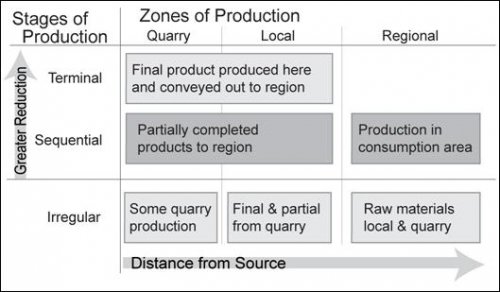2.4.2. Analysis of a production system
In a multi-tiered approach that examines evidence from workshops, from residential sites in the vicinity of the quarry and finally lithics from more distant, consumption contexts, Ericson (1984) describes a general "Lithic Production System".
|
Name |
Variable (numerator) |
Normalizer (denominator) |
Unit(s) |
|
Exchange Index |
Single source |
Total material |
Count, weight, % |
|
Debitage Index |
Debitage |
Total Tools and debitage |
Count, weight, size, % |
|
Cortex Index |
Primary and secondary reduction flakes |
Total debitage |
Count, % |
|
Core Index |
Spent cores |
Total cores and tools |
Count, % |
|
Biface Index |
Bifacial Thinning Flakes |
Total debitage |
Count, % |
Table 2-5. Measurement indices for procurement system (after Ericson 1984: 4).
The indices presented by Ericson depend upon general artifact type categories and provide a basis for comparing activities between workshops, local sites, and distant consumption locales. Note that Ericson did not separate complete flaked stone artifacts from broken artifacts, as this was the early 1980s, and thus his resulting indices using weight measures were likely skewed.
The measures in Ericson's table emphasize the goal of allowing comparability between archaeological datasets over widely studied areas by principally relying on general metrics that are commonly gathered in laboratory analysis. In contrast, the current Upper Colca study employed technical analyses of complete flakes and cores in order to highlight differential reduction strategies between assemblages, or between bifacial core versus flake-as-core reduction.
Figure 2-6. Stages of production from quarry, local area, and region (after Ericson 1984: 4).
Ericson presents the spatial distribution of lithic production in terms of stages of production and zones of geographic proximity to the source area. A consistent implementation of this approach on a local and regional scale requires the sourcing (visually or chemically) of the lithic material. Despite the use of commonly gathered measures in indices of production, it would be necessary to ensure that relatively consistent practices in excavation and analysis procedures were in place to permit this kind of regional comparability.
Ericson asserts that workshops should be studied on a general level rather than pursing spatial and temporal variation in activities at the source. He writes that if "there are a number of different workshops at the source, the data must be merged to form a composite picture of production" (Ericson 1982: 133). The emphasis is on documenting the predominant production strategy at a given source area, but at the cost of characterizing variability within a production context. If changes in the use of a given material have been differentiated from stratified deposits at consumption sites in the larger region, how are these changes to be linked with production activities? While workshop sites often lack datable materials or temporally diagnostic artifacts, collapsing all excavated workshop data, and perhaps surface evidence as well, into a single composite picture sacrifices the detail that stratified deposits can provide.
Excavation and analysis procedures in Ericson's California dataset appear to be relatively consistent for the past half-century, however the systematic collection and analysis of non-diagnostic lithics has been historically deemphasized by archaeologists in some regions of the world, such as the south-central Andes. Archaeological practices worldwide have not placed equal emphasis on gathering and quantifying lithic artifacts which would lead to problems in applying the kinds of metrics Ericson suggests on a regional scale. Ericson's approach emphasizes the use of quantifiable and comparable measures over a geographically extensive region.
Barbara Purdy (1984) emphasizes chronology in her study of a chert procurement site in Florida. She did not find datable, organic remains in association with stratified excavations that would provide greater evidence of the temporal associations, but the strata in her test units allowed her to differentiate distinct episodes of use of the site. She found that weathered chert artifacts in a sandy-clay soil were separated by a lithologic discontinuity from less-weathered artifacts produced using a different technology. She was also able to use the relative weathering of chert and thermoluminescent dating on fire-altered chert cobbles from the quarry site.

